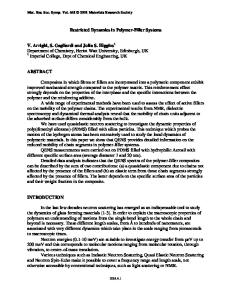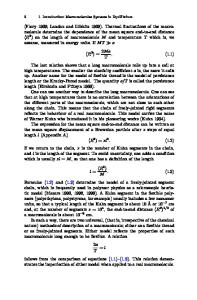Polymer Dynamics in Polymer-Nanoparticle Interface
In this chapter, we focus on the polymer nanoparticle (either spherical, anisotropic or free surface) interface and specifically on polymer dynamics considering attractive interaction with the nanoparticles. We concisely report the main experimental and c
- PDF / 1,098,551 Bytes
- 20 Pages / 439.37 x 666.142 pts Page_size
- 90 Downloads / 396 Views
Polymer Dynamics in PolymerNanoparticle Interface Argyrios V. Karatrantos and Nigel Clarke
Abstract In this chapter, we focus on the polymer nanoparticle (either spherical, anisotropic or free surface) interface and specifically on polymer dynamics considering attractive interaction with the nanoparticles. We concisely report the main experimental and computer molecular simulation studies regarding the polymer mobility at the interface. We show how changes of the glass transition (Tg ) are correlated with segmental dynamics and relaxation at the interface.
4.1 Introduction By dispersing spherical [1–9] or anisotropic nanoparticles [10–18] into a dense polymer matrix several material properties can be enhanced, whether mechanical [19, 20], electrical, optical [21] or plasmonic [22]. Although there is a plethora of experimental studies into these kinds of properties or regarding the polymer structure [23–33], there is still controversy and much less focus on the dynamics of polymers [34, 35] in the polymer-nanoparticle interface. Some research studies claim that there is a “bound” polymer layer around the nanoparticle surface, which is immobile [36–38], whereas other research efforts dispute this result insisting that the polymer around the nanoparticle has a certain translational and segmental dynamics [39, 40]. It is not only the packing of chains in the interfacial regions that contributes to the material property enhancements in nanocomposites [42, 43] but also the “bound” polymer layer, which is formed on nanoparticles interacting favorably, or even the chemical heterogeneity of interfacial layers [39, 44] around the nanoparticles contributes largely to the mechanical reinforcement that is observed in nanoparticle-filled elasA. V. Karatrantos Materials Research and Technology, Luxembourg Institute of Science and Technology, 5, Avenue des Hauts-Fourneaux, 4362 Esch-sur-Alzette, Luxembourg e-mail: [email protected] N. Clarke (B) Department of Physics and Astronomy, University of Sheffield, Sheffield S3 7RH, UK e-mail: [email protected] © Springer Nature Switzerland AG 2021 V. V. Ginzburg and L. M. Hall (eds.), Theory and Modeling of Polymer Nanocomposites, Springer Series in Materials Science 310, https://doi.org/10.1007/978-3-030-60443-1_4
81
82
A. V. Karatrantos and N. Clarke
Fig. 4.1 Schematic representation of the interface region between a filler and a polymer matrix. Reprinted with permission from [41]. Copyright American Chemical Society
tomers. Polymer mobility near nanoparticle surfaces has been extensively discussed qualitatively, however, a direct experimental measurement of polymer mobility in the nanocomposites is not easy. In this chapter, we do not aim to report on and discuss studies that investigate the dynamics of polymers in melt [45, 46] or under confinement since there are excellent articles [47, 47–50, 50, 51] and reviews [45, 52] available. Neither do we aim to report, in detail, experimental techniques (results) [24] nor different molecular simulation techniques f
Data Loading...











